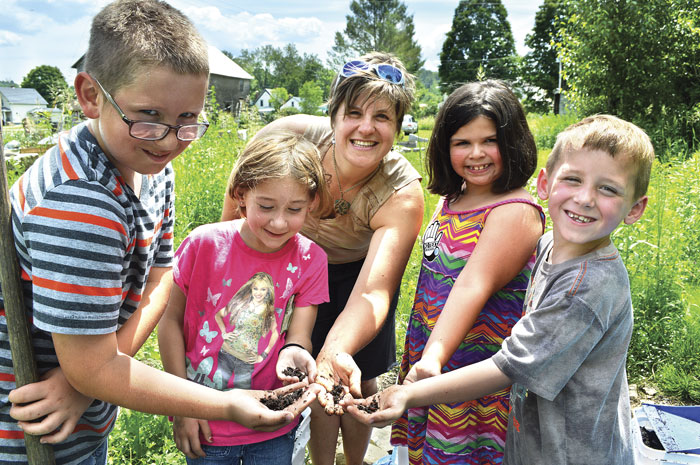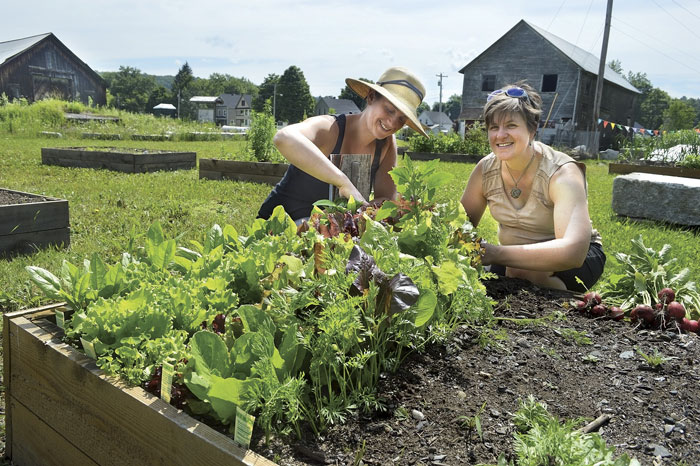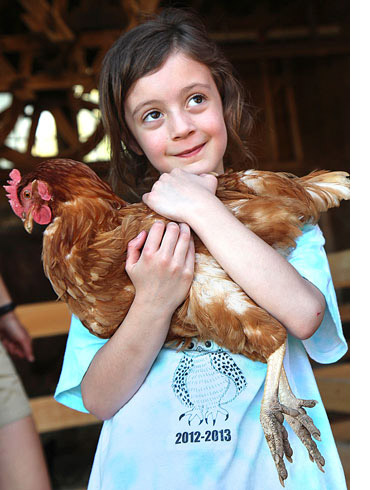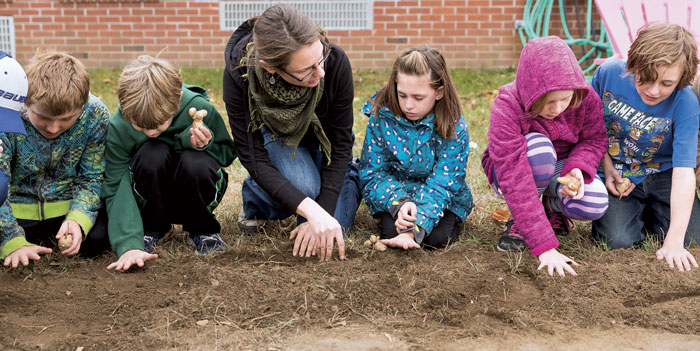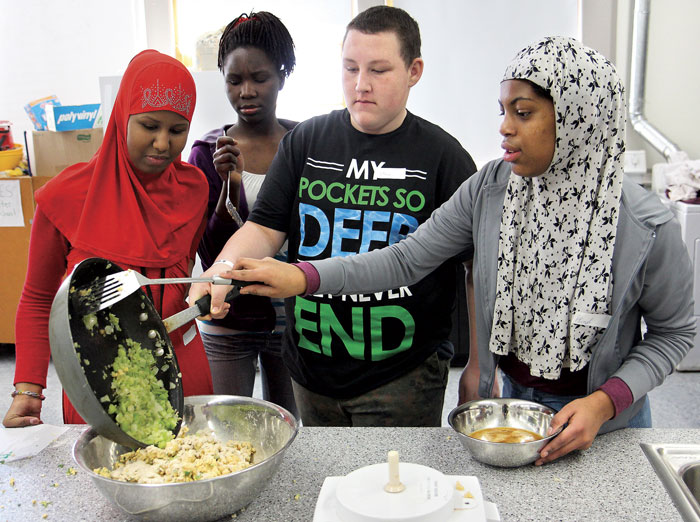| Building Food Resilience in Vermont | |||||||||
| by K.C. Whiteley | |||||||||
Right now, Vermont has about 800 operating dairy farms and an equal number of vegetable and crop farms, primarily small-scale operations. Vermont Public Radio recently reported that close to a third of our farms are run by Vermonters over age 65, and according to a recent study by Land for Good, 91 percent of those have no one younger lined up to take over. On the plus side, from 2002 to 2013, food system employment in Vermont increased by 5,589 jobs (9.9 percent). Over 60,000 Vermonters are directly employed in our food system. What is the future of farming in Vermont? What will our iconic landscape look like in a generation or two? And who will be growing the food we eat?
Sarah Waring leads the Center for an Agricultural Economy (CAE) in Hardwick, the centrifugal force harnessing what has been described as an economic and community renaissance. Waring estimates that about 8 to 10 percent of the food we consume in Vermont is produced here, with milk, dairy products, and animal feed making up the vast majority of food produced. Waring also points out the critical importance of food as an economic system, with one out of every four people in the US working somewhere in the food system, from truck drivers to grocery clerks to field workers. About 60 percent of those workers are paid less then a livable wage. Our national food production is based on a system that is unjust and inequitable. Food producers, threatened with cheaper sources of food, are pressured to keep prices as low as possible, and so it becomes a race to the bottom. Vermont is small potatoes in this global market. The CAE is working hard to make a difference in Vermont’s food system by providing the networking, infrastructure, and expertise small farmers need to get their products to market. Kathryn A. Olson, an economic researcher, has studied what many call the Hardwick renaissance and names several factors related to its success as an agricultural business model, including the “diversity of enterprises, including the right balance of local and export, a highly networked and collaborative business community and a nonprofit hub.” The CAE offers all of these. It owns and operates the Vermont Food Venture Center, a state-of-the-art, shared-use commercial kitchen and food-processing facility available to farmers and community groups. Most of the produce goes to institutions like local schools, colleges, and hospitals. These are markets that are hard for individual growers to access, so the CAE acts as the broker. They also work with a network of local farmers to move their products to markets across New England. In her 2015 paper, Growing in Place: Building a Local Food Economy in Vermont, Olson writes: “The Hardwick economy has fared better than the Vermont average. Since 2000, 285 jobs have been created, more than half of them due to the four area agri-businesses, the CAE, and the Food Venture Center. It has made a big difference in this town of just over 3,000. Unemployment has fallen in Hardwick since 2000 in spite of the 2008 recession, and the mean household income in Hardwick has increased by 18%, a remarkable rise compared to the decrease in the statewide mean income of 2.3% over the same period of time.”
Hopeful news indeed. However, Olson also points out that the percentage of area families living below the poverty line during this period (2000–2012) has remained unchanged, indicating that the positive impacts of the growth of the local food economy have not lifted all boats equally. Believing consumer education is key to address these challenging community issues, the CAE works with the Hardwick Area Food Pantry to deliver fresh produce, runs community-led workshops on cooking, nutrition, and basic household management, and builds the community’s capacity to grow and access local food, putting their vision of collaborating with and supporting the local community out front. As the CAE notes on its website: “An equitable food and agricultural economy has created empowered, interdependent communities with shared mutual goals, within our greater Hardwick region, that are socially and economically thriving, and contribute to a vital ecological future.” Waring believes this vision is the “embodiment of being socially and environmentally conscious” and recognizes that “food equity and access are tied up in other issues, such as transportation, livable wages, childcare, opiate addiction, and generational poverty. Out of this work has grown the Northeast Kingdom Community Organizing Project, a regional network of partners who believe that working across sectors and groups is a critical approach to successfully addressing our issues of rural poverty and food insecurity.” I asked Waring about the capacity of local markets to absorb and sustain the expanding local food production. She enlightened me with some data. About 7 percent of our general food consumption comes from local sources. These are what she terms intermediated sales, meaning any sale where you don’t buy directly from the grower. Add in farmers’ markets (according to the USDA, Vermont has more farmers’ markets and CSAs than any other state) and you get to 8 percent. Institutions (hospitals, schools, colleges) buy between 10 and 12 percent local. Based on her data, Waring says most of their growers have topped out their farmers’ market direct sales, which means “our production has to be more diversified to reach the next plateau of sales. There’s only so much room for farmers’ markets and CSAs and direct sales.” The CAE encourages growers to diversify and think in different scales. The CAE also can move local produce to grocery stores and larger, regional markets. Getting fresh local produce into our schools, educating students, teachers, and cafeteria staff about healthy foods, and connecting kids with community-based learning are Betsy Rosenbluth's primary aims as project director of Vermont Feed (Farm to School Food Education Every Day).
“When you look at reducing obesity or improving farm viability, it’s a complex problem in a complex system,” said Rosenbluth. “If you understand the system and identify the levers that can change the system, when the grant funding is gone, you have actually changed the school cafeteria system. You have to change the whole system, connecting kids to food, to farms, integrating education into the curriculum. It requires more effort up front, but then you hit the tipping point. The bottom line is not the only value.” Despite the bureaucratic hurdles presented by the USDA food system, today, there are school gardens in almost every school, menus have totally changed to include an array of healthy fresh food, and a growing percentage of schools purchase local foods. Rosenbluth has worked tirelessly to find win-wins around the discouraging aspects of the public school food systems to integrate food system education into school curriculum and create opportunities for hands-on, place-based learning. In 2009, seeing the growth in interested schools across the state, a group of organizations (now numbering about 35) created the Vermont Farm to School Network to provide coordination and advocacy to reach this goal: “By 2025, 75 percent of Vermont Schools will lead the cultural shift to a values-based food system that engages 75 percent of our students in integrated food system education; community-based learning; nourishing universal meals; and the experience of self-efficacy; purchasing at least 50 percent from a socially just and environmentally and financially sustainable regional food system.” Rosenbluth coordinates the network and can tell you how many schools serve breakfast, have salad bars, and purchase local produce. She is currently rolling out a survey of every school in the state to “get a snapshot of how far we have to go.” She points to the increase in school nutrition programs, including some that extend through the summer months, for reducing childhood hunger in Vermont. Of equal importance to her is how kids feel connected to their community and to the local farmers who grow their food. The hands-on experience of growing food or going to a farm and pulling carrots out of the ground can change behaviors and influence future choices. Engaging students through the lens of food raises awareness about all the factors that are interconnected. How are rising temperatures and climate change impacting our food production? Experiential education leads young people to understand and value how the environment and current issues like climate change are linked. The value of education is “you want citizens who understand how all these things are linked and support policies and investments that support the system.” She reminded me that it was young people who started the recycling movement and pushed adults to do the right thing, which shifted cultural norms. As future consumers, young people can demand a different system.
The Vermont legislature recognized the value of the Farm to School Network by establishing funds (currently $181,000) that the network hopes will grow to a $500,000 annual investment. The network uses that money to leverage private dollars from donors and foundations that see the long-term impact of connecting kids and their communities with the local agriculture economy. Rosenbluth credits Vermont’s congressional delegation, especially Senator Leahy, for passing the federal Farm to School Act of 2017 based on Vermont’s.
Early research is beginning to show that kids who know farmers actually eat more fruits and vegetables than kids who don’t. Experiential education improves classroom behaviors, decreases nurse visits, and can play a role in obesity prevention. With over a quarter of Vermont teens overweight, Rosenbluth believes the farm-to-school program can help to reverse that trend. So how does this model hope to influence the future of farming in Vermont? First, for kids who are more and more disconnected from the land and where their food comes from, Farm to School engages students in their local food systems with hands-on experiences like school gardens and learning about the benefits of fresh, healthy foods that promote healthy lifestyles. Teachers and schools are actively increasing access to healthy foods and providing opportunities and access to experiential Farm to School curriculum activities. Rosenbluth is in this for the long haul and believes they can reach a tipping point where the Farm to School Network changes the system, buying more and more local and being integrated into the way we educate and feed our children. “Personally I find Farm to School is the place where we can help young people to be change makers and we need that in this world. That motivates me on days when the system works against me.” Hardwick’s Center for an Agricultural Economy and the Vermont Farm to School Network are two successful and diversified enterprises that connect all aspects of a local food system economy with the goal of thriving landscapes and communities. Seeing the hard work and commitment involved, it’s clear there are no quick fixes or easy solutions to how we can become more self-sufficient in our own food production. But there are lots of good ideas and inspiring, creative people and models to learn from.
|
|||||||||
|
K.C. Whiteley is a member of the 350VT advisory board. 350VT organizes, educates, and supports people in Vermont to work together for climate justice—resisting fossil fuels, building momentum for alternatives, and transforming our communities toward justice and resilience.
|
||||||||

